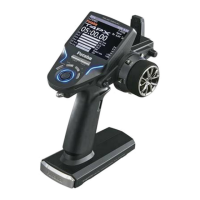S.Bus Servo
S.BUS function setup
(Preparation)
-S.BUS/S.BUS2 servo is read referring to the explanation of page 127.
1
Select the setting item by (JOG) button up, down, left, or right operation.
Set the value by (+) and (-) button.
ID
Displays the ID of the servo whose parameters are to be read. It cannot be changed.
Channel
This is the S.BUS system channel assigned to the servo. When
connected to the receiver S-BUS2 connector as an S.BUS sys-
tem, the channel used by the transmitter is assigned. When the
normal receiver channel is used, channel setting is unneces-
sary.
Reverse
The direction in which the servo rotates can be changed.
Neutral
The neutral position can be changed. When the eutral offset is
large value, the servo’s range of travel is restricted on one side.
Travel(L)
The maximum left travels centered about the neutral position
can be set independently.
Travel(R)
The maximum right travels centered about the neutral position can be set independently.
Speed
Speeds can be matched by specifying the operating speed. The speed of multiple servos can be matched without be-
ingaffectedbymotoructuations.Thisiseffectiveforloadtorquesbelowthemaximumtorque.
However, note that the maximum speed will not be exceed what the servo is capable of even if the servos operating
voltage is increased.
Soft Start
Restricts operationinthespecieddirectiontheinstantthepoweristurnedon. By usingthis setting,therst initial
movementwhenthepoweristurnedonslowlymovestheservotothespeciedposition.
Stop Mode
Thestateoftheservowhentheservoinputsignalislostcanbespecied.The"Hold"modesettingholdstheservoin
its last commanded position even if using AM or FM system.
Smoother
This function makes servo operation smooth. Set it according to your taste. Normally set it to "ACT". Set it to "INH"
when want especially quick operation. When the smoother function was set to "ACT" and the servo was operated the
distance up to the target position is hanged in steps so movement is smooth.
Dead band
Thedeadbandangleatstoppingcanbespecied.
[Relationship between dead band set value and servo operation]
Small - Dead band angle is small and the servo is immediately operated by a small signal change.
Large - Dead band angle is large and the servo does not operate at small signal changes.
(Note)
If the dead band angle is too small, the servo will operate continuously and the current consumption will in-
crease and the life of the servo will be shortened.

